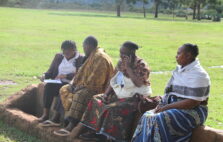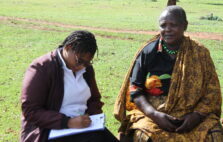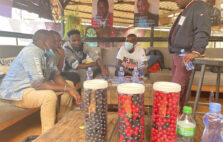“Now I recognize my journey to wellness matters most to me, you as health workers please help me without judgment so that…my health comes first,” – Cecilia Daati, farmer, Manyara, 59
The 95-95-95 vision is where 95% of people know their HIV status, 95% are receiving HIV treatment, and 95% are virally suppressed. To achieve the 95-95-95 vision in Tanzania, we must first:
- Understand why people make decisions in the way that they do.

- What drives them?
- What holds them back?
- What are their motivations, beliefs and fears?
- How do these combine to influence decisions?
Understanding means engaging with people and asking them these questions and it is through understanding that we can promote social and behavioral change. This is especially important when understanding why persons living with HIV (PLHIV) may choose to adhere with their antiretroviral therapy regime or not.
The USAID, Afya Yangu (My Health) Northern (AYN) Project has embraced this challenge and deployed human centered design (HCD) as a method of engaging with PLHIV to understand their decision making around ART compliance or non-compliance. The B-OK Kit and animation video were developed in earlier phases of the AYN Project. These visual tools explain how antiretrovirals (ARVs) work in the body and encourage ARV adherence for PLHIV to maintain good health and viral suppression. The tools themselves were developed by understanding why people either do or do not comply with their ART regime. This next phase of the AYN Project aims to explore how people in the community understand these tools and their efficacy in encouraging PLHIV to stay on ARTs.
B-Ok Kit
Explaining viral suppression and the importance of adherence to ARVs remains a barrier to living HIV safe. This simple in-hand tool comprising of three bottles of beads provides a unique and easy way for health care providers (HCP) to explain viral suppression and the important of ART to clients. By explaining viral suppression simply and accessibly, this solutions seeks to reduce stigma and increase awareness of HIV science.
Execution: The B-OK Kit lives on the desk of the HCP. These three small bottles contain red and white beads that allow nurses and doctors of all levels of training to understand antiretrovirals and viral suppression. This is an accessible, relevant way to explain complex scientific concepts for PLHIV to live better lives.
Methodology: The B-Ok Kit is a simple tool that explains how people living with HIV can live with very little viral load in their body. This tool is so simple that the client can be shown it with the HCP and carry the message with them. HCP are trained or orientated in the kits and the audio-visual video remains with them as a reminder and prompt.
Target Audience: People living with HIV (those who are virally suppressed and not), HVP who work with PLHIV, family and loved ones.
Why This Can Work
The B-Ok Kit is an existing solution that has been adapted by agencies in South Africa, Zimbabwe, Malawi and Eswatini with great success. We believe that this solution can provide an interactive and relevant tool to HCP working with HIV in Tanzania that can have lasting impact on indicators and outcomes for PLHIV.
The B-Ok explainer video that tells HCP how to use the B-Ok bottles in order to explain viral suppression and the important of ART to clients. By explaining viral suppression simply and accessibly, this solutions seeks to reduce stigma and increase awareness of HIV science.
Execution: This animated video is in easy-to-understand Kiswahili. The video is easily available as a shareable video that can live as a link or a movie on a phone, tablet, computer, or hard drive. It can be shared via Whatsapp, message, and email.
Methodology: The audio-visual video remains with them as a reminder and prompt. The video uses informal, friendly language, encouraging HCPs to be empathetic to clients and also use language that is accessible.
Target Audience: PLHIV (both those who are virally suppressed and those who are not), HCP, PLHIV, family and loved ones.
Cecilia’s Story
At a prayer meeting in December 2022, a pastor prayed for Cecilia and promised her that she had been completely healed from HIV.
Cecilia stopped taking her ARVs and moved to the countryside to focus on farming. By October, 2023 Ceciliaʼs health was deteriorating so significantly that she was forced to return to Loto Village to live with her grandchildren. By March 2024 Cecilia felt so ill that she asked her neighbours to ask the Community Health Workers (CHW) at Dareda Hospital to come and see her. Recognizing that her health had declined, the CHW took Cecilia to Dareda Hospital for treatment.
At the hospital, the CHW used the B-Ok Kit and animated videos to explain what was happening in her body. They explained how a high viral load occurs in the body and that by using ARTs you can reduce the viral load and maintain good health. Cecilia understood and promised to take her ARTs but expressed that she felt ashamed to go back to the Care and Treatment Centre (CTC) as she had been absent from the clinic for so long. Understanding how she felt, the CHWs will deliver ARV medication to Cecilia when she runs out in the future.
How We Change the Future
Cecilia’s story shows how important it is to consider people when we think about how to change the broader HIV landscape in Tanzania and beyond. PLHIV have their own beliefs, motivators and fears that we need to understand so that we can encourage them towards better health seeking behavior.
By using tools that explain information in a simple way, listening to peopleʼs concerns and recognizing their understanding of their condition we have a better chance of achieving our unified goal of 95-95-95.
The USAID Afya Yangu (My Health) Northern Project is designed around client-centered approaches to address gaps in HIV, TB and family planning service delivery, while continuously building and transferring the capacity of local stakeholders for sustainable and country-led ownership. USAID Afya Yangu (My Health) Northern focuses intensely on direct service delivery across all regions in early project years, ensuring that gaps to epidemic control are identified, and tailored solutions are designed to meet the needs of vulnerable populations.
From the American People with support from the U.S. President’s Emergency Plan for AIDS Relief, through USAID.





